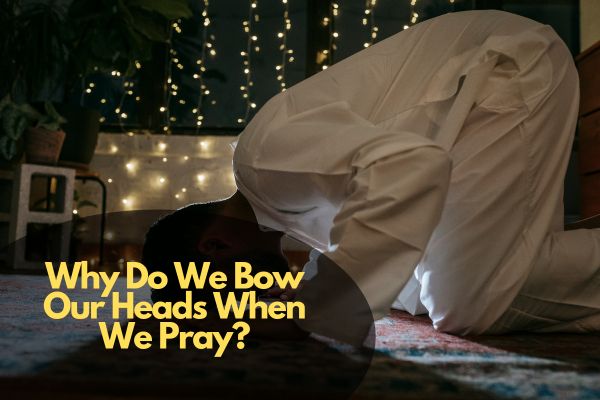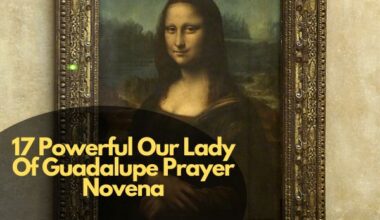Table of Contents Show
When observing people engaged in prayer, it is common to see them bow their heads in reverence and humility.
Whether in a religious setting or private moments of devotion, the act of bowing one’s head has become deeply ingrained in the practice of prayer.
But have you ever wondered Why Do We Bow Our Heads When We Pray? Is it merely a cultural tradition, or does it hold a deeper significance? In this blog post, we will explore the reasons behind the act of bowing our heads during prayer.
Why Do We Bow Our Heads When We Pray?
We will look into its historical origins, religious symbolism, and the personal significance it holds for individuals in their spiritual journey.
By understanding the purpose behind this physical gesture, we can gain a deeper appreciation for the power and meaning of prayer in our lives.
Origins in Various Religions
Bowing, as a gesture of reverence and submission, has deep roots in various religious traditions across the globe. It’s fascinating to witness the diverse ways in which this act has been woven into the fabric of different faiths.
Christianity
Why Do We Bow Our Heads When We Pray: In Christianity, the act of bowing may not be as standardized as in some other religions, but it certainly holds significance. Often, you’ll find Christians bowing their heads during prayer as a symbol of humility and respect before God. This simple yet profound gesture reflects the acknowledgement of a higher power and the reverence that believers hold for the divine.
Islam
Why Do We Bow Our Heads When We Pray: In Islam, the practice of bowing, known as Sujud or prostration, is a fundamental element of daily prayers. This act involves bowing the head to the ground, symbolizing complete submission to Allah. The physical act of lowering oneself to the earth underscores the worshipper’s humility and devotion, creating a direct connection between the individual and the divine.
Hinduism
Hinduism, with its rich rituals and traditions, incorporates bowing in the form of Namaste. This practice involves bringing the palms together in front of the chest and bowing slightly. Namaste signifies the recognition of the divine spark within each person and serves as a gesture of respect. The bowing aspect emphasizes humility and equality before the sacred.
Buddhism
Why Do We Bow Our Heads When We Pray: In Buddhism, bowing is a ritual that goes beyond a mere physical act. Monks, in particular, perform full prostrations, lowering themselves until their foreheads touch the ground. This profound gesture symbolizes the surrender of the ego and the acknowledgement of a higher spiritual path. Bowing in Buddhism is not just a set of movements; it is a transformative practice that signifies deep humility and respect.
Bowing, in all these religious contexts, is a symbolic bridge between the earthly and the divine, a gesture that transcends language and cultural barriers. Understanding the roots of bowing in different religions unveils not only a shared reverence for the sacred but also the unique ways in which each faith expresses its devotion through this universal act of humility.
Symbolism in Different Cultures
Bowing is not confined to religious practices; it extends its significance into various cultural contexts, serving as a symbol of respect, acknowledgement, and politeness.
Japan
In Japanese culture, bowing, known as “ojigi,” is deeply ingrained in daily life. The angle and duration of the bow convey different messages. A slight nod may express gratitude or acknowledgement, while a deeper bow may signify profound respect. Bowing in Japan goes beyond mere courtesy; it reflects the cultural emphasis on humility and harmony in human interactions.
Middle East
In Middle Eastern cultures, bowing, or a similar gesture like a slight lowering of the head is often a sign of respect. This is particularly evident in traditional greetings, where individuals bow or incline their heads slightly when meeting others. The act is rooted in the values of honour and politeness, emphasizing the importance of showing deference to one another.
Western Cultures
While handshakes are more common in Western cultures as a form of greeting, the subtle nod or bowing of the head is not absent. In formal settings or situations where a handshake might be impractical, a nod can serve as a non-verbal display of acknowledgement and respect.
Focus and Concentration
The act of bowing during prayer isn’t merely a physical gesture; it has profound psychological implications, aiding in focus and concentration.
Physical Cue for Focus
Bowing serves as a physical cue, signalling the beginning of a sacred moment. The intentional act of lowering the head becomes a ritualistic entry into a state of mindfulness. By engaging the body, individuals can more effectively shut out external distractions, allowing them to concentrate on their prayers with heightened focus.
Shutting Out Distractions
In a world filled with constant stimuli, finding moments of concentration can be challenging. Bowing becomes a deliberate action, a personal commitment to set aside distractions and immerse oneself fully in the spiritual experience. The physical act becomes a mental reset, creating a sacred space for undivided attention.
Body-Mind Connection
Bowing, beyond its religious connotations, fosters a unique connection between the physical and the spiritual.
Holistic Experience
The act of bowing engages both the body and the mind, turning a simple gesture into a holistic experience. It’s not just about the physical act of lowering the head; it’s about connecting the physical self to a higher plane of existence. This integration of body and mind enhances the depth of the prayer experience.
Unity and Mindfulness
As the body bows, the mind follows suit, creating a sense of unity and mindfulness. This synchronised movement fosters a deep connection with the divine, reinforcing the idea that prayer is not just a verbal or mental exercise but a complete engagement of the self.
In exploring the symbolism of bowing in diverse cultures and understanding its psychological aspects, it becomes evident that this seemingly simple act transcends its physicality. Bowing becomes a universal language, speaking to the values of respect, concentration, and the intricate connection between the body and the mind.
Conclusion
In the exploration of why we bow our heads when we pray, it becomes clear that this age-old practice is far more than a mere physical gesture. It is a universal language spoken across religions, cultures, and personal beliefs, weaving together threads of symbolism, respect, and mindfulness.
Bowing, whether in religious ceremonies, cultural exchanges, or personal moments of reflection, serves as a powerful symbol of humility and submission. Its origins are deeply rooted in various faiths, where it signifies not just a physical act but a profound connection with the divine. From Christianity to Islam and Hinduism to Buddhism, the act of bowing unites believers in a shared expression of reverence.
Beyond the religious context, bowing finds its place in cultural practices, offering a gesture of respect that transcends linguistic barriers. In Japan, the depth of a bow communicates nuances of gratitude and acknowledgement, while in the Middle East, a nod of the head signifies honour and politeness. Even in Western cultures, where handshakes are more common, a subtle bow or nod is not devoid of significance.
The psychological dimensions of bowing are equally compelling. It serves as a physical cue, a deliberate action that aids in focus and concentration during prayer. By shutting out distractions and engaging the body, individuals create a sacred space for a deeper spiritual experience. The body-mind connection established through bowing enhances the overall sense of unity and mindfulness, making prayer a holistic engagement of the self.
Frequently Asked Questions (FAQs)
1. Is bowing our heads during prayer a universal practice?
The act of bowing one’s head during prayer is commonly observed across various cultures and religious traditions. While the specific manner and degree of bowing may vary, the gesture itself is found in many different faiths and spiritual practices. It is a unifying symbol of reverence and submission in the presence of a higher power.
2. What is the significance of bowing our heads in prayer?
Bowing our heads during prayer serves multiple purposes. Firstly, it is a physical expression of humility and surrender, acknowledging that we are finite beings in the presence of the Divine. Secondly, it helps to create a focused and introspective atmosphere, allowing us to detach from external distractions and connect with the spiritual realm. Lastly, bowing our heads can serve as a symbolic gesture of respect and honour towards the divine entity we are addressing in our prayers.
3. Are there variations in the practice of bowing our heads in different religious traditions?
Yes, there are variations in how different religious traditions approach the act of bowing the head during prayer. For example, in some traditions, the forehead may touch the ground, symbolizing complete prostration and submission. In others, a slight bow of the head may be sufficient. The specific customs and rituals associated with bowing the head can vary, but the underlying intention remains the same – to express reverence, humility, and a deep connection with the divine.








